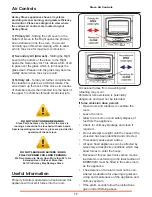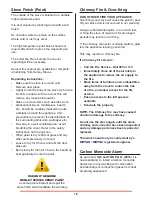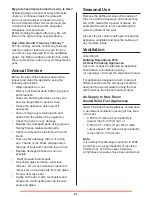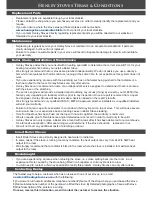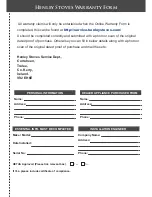
17
Air Controls
Henley Stoves appliances have air systems
providing cleaner burning, and greater efficiency
and control. Please see diagram to view where
the various air controls are located on your
Henley Stove
1)
Primary Air
- Sliding the Left Lever on the
bottom of stove to the Right opens the primary
air and allows air into the stove. You would
normally open this when starting a fire to allow
air into the stove for maximum combustion.
2) Secondary Air (Airwash)
- Sliding the Right
Lever at the bottom of the stove to the Right
opens the Secondary Air. This allows a film of air
to pass over the glass which in turn keeps the
glass clean. Please note the glass may become
visibily darker when the stove is cold.
3) Tertiary Air
- Tertiary air further compliments
the cleanburn system as a third air intake. The
air is drawn up the back of the stove via a series
of chambers and is then injected into the back of
the upper fire chamber through small steel jets.
DO NOT USE YOUR BARE HANDS
Stove Parts become very hot while the stove is
running so should not be touched with bare hands.
Special operating tools and or a glove are provided for
operation of the hot stove.
DO NOT LEAVE AIR LEVERS / RODS
FULLY OPENED FOR LONG PERIODS.
We Recommend to Never Open More than 60%, As
Extended Use of Stove at More than
60% Proficiency May Damage Stove.
Useful Information
Properly installed, operated and maintained, this
appliance will not emit fumes into the room.
Occasional fumes from de-ashing and
refuelling may occur.
Persistent fume emission is potentially
dangerous and must not be tolerated.
If fume emission does persist:
• Open doors and windows to ventilate the
room.
• Leave the room.
• Allow fire to burn out and safely dispose of
fuel from the appliance.
• Check for chimney blockage and clean if
required.
• Do not attempt to relight until the cause of the
emission has been identified and corrected
• If necessary seek expert advice.
• All open flued appliances can be affected by
temporary atmospheric conditions which may
allow fumes to enter the house.
• Because of this an electronic carbon monox-
ide detector conforming to the latest edition of
BSEN50291 must be fitted in the same room
as the appliance.
• The existence of an alarm must not be con-
sidered a substitute for ensuring regular ser-
vicing and maintenance of the appliance and
chimney system.
• If the alarm sounds follow the instructions
given under Warning above.
Stove Air Controls















